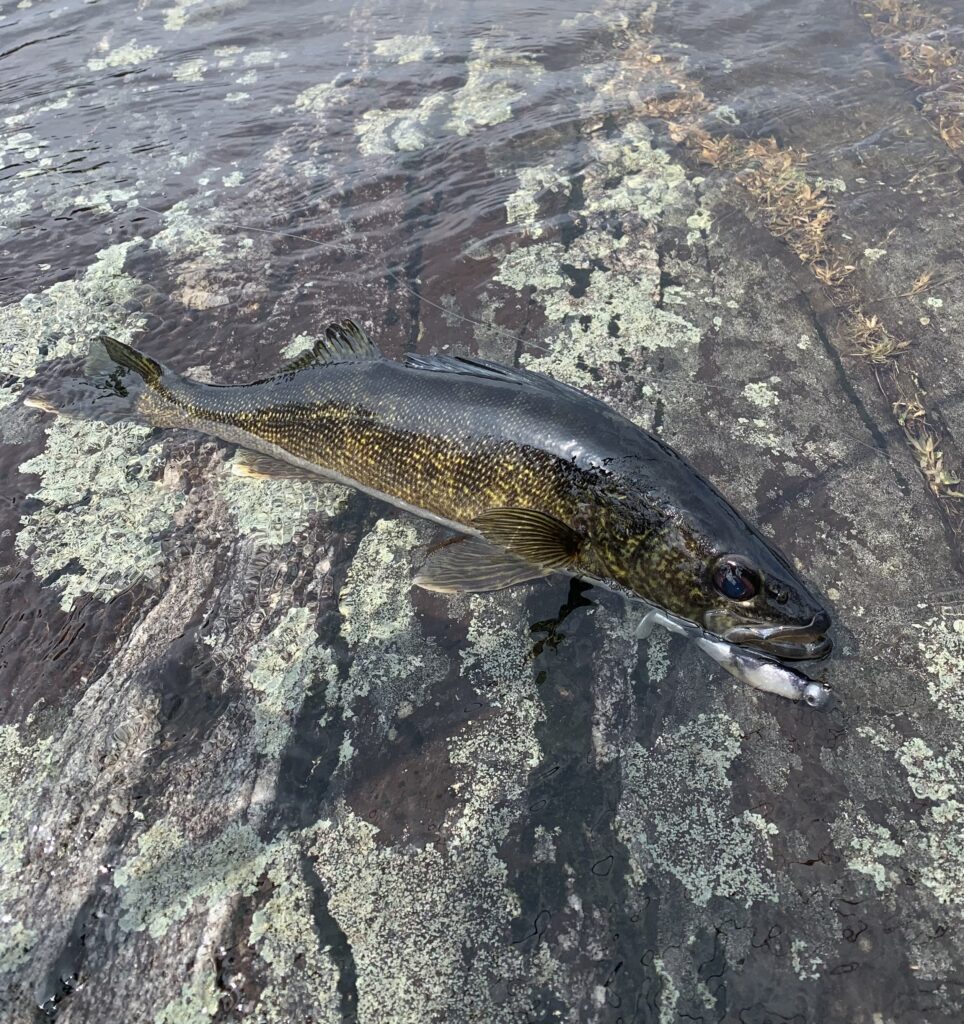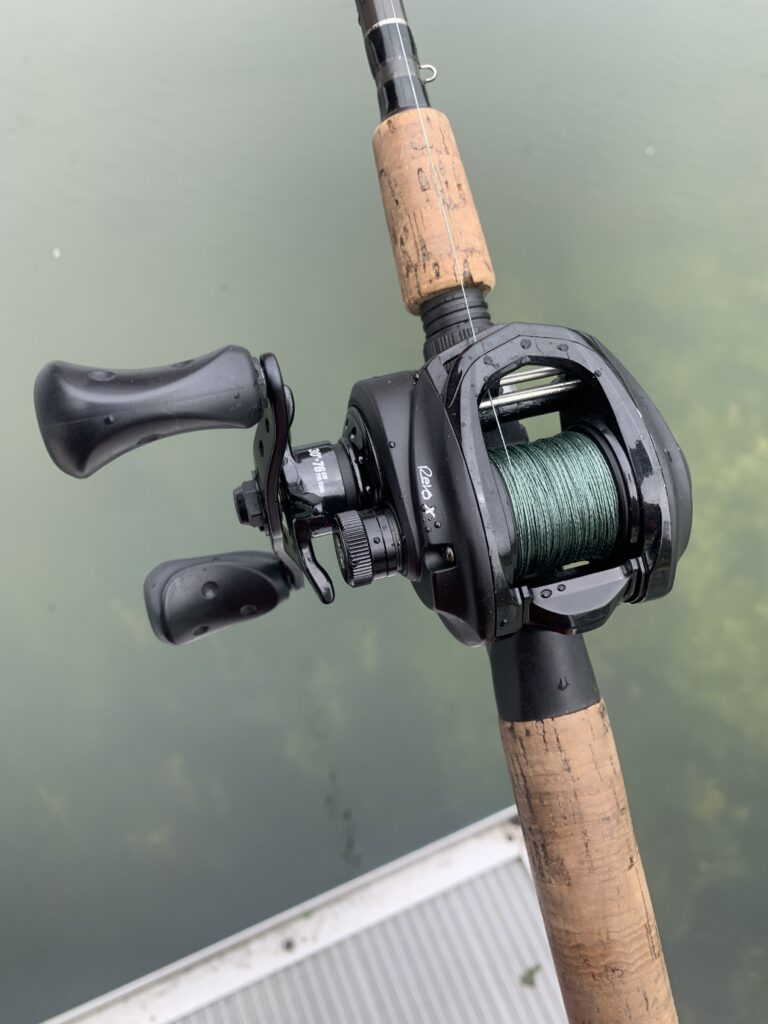Hey there, fellow anglers! If you’re looking to up your walleye fishing game, you’ve come to the right place. In this comprehensive guide, I’ll share my own experience with applying the power of bait finesse fishing to walleye. Whether you’re a beginner or an experienced angler, this guide will provide valuable insights and techniques to help learn about bait finesse for walleye and help you apply it in the future. As always, fishing education and conservation are our priorities here at The Angler’s Line. Feel free to sign up for our free newsletter to join our community and stay up to date! Lets get started!
Table of Contents:
- Understanding Bait Finesse For Walleye
- Bait Finesse Gear
- Bait Finesse Techniques For Walleye
- Finesse Baits For Walleye
- Walleye Location
- Bonus Tips
- Conservation
Understanding Bait Finesse for Walleye Fishing
Let’s start by understanding what bait finesse for walleye is all about. Bait finesse is a new technique that involves using lightweight baitcasting tackle specialized for finesse presentations. Bait finesse grew in popularity in the bass fishing community, but has since spread to other species as well. These techniques are especially effective when walleye are finicky and require you to downsize your presentation.
Essential Gear for Bait Finesse
To embark on your bait finesse journey, you’ll need the right gear. Let’s break it down:
Fishing Rod Selection
First and foremost, look for a specialized bait finesse rod. Bait finesse rods are extremely lightweight compared to traditional baitcasting setups. Typically, a light or medium-light power baitcasting rod between 6.5′ and 7′ is a good starting point. The lightweight rod and will allow you to effectively cast small finesse lures for walleye.
Reel Options
Reels are probably to the most important piece of equipment when it comes to bait finesse fishing. Traditionally, baitcasting reels work best with heavier lures and are relatively impossible to use with anything lightweight. If you wanted to buy bait finesse gear in the past, you used to have to pay a hefty price. However thanks to several companies making the technique more mainstream, bait finesse reels are more accessible than ever. These reels are specifically designed for lightweight lures, and provide the necessary control to fish them effectively.
Fishing Line Selection
Choosing the right fishing line is crucial for successful finesse fishing. I recommend a low-visibility fluorocarbon line. Anywhere from 4-8 lbs is a good starting point when bait finesse fishing for walleye. Another option is using a braid main line with a fluorocarbon leader. This is based on personal preference and the specific technique you will be using. For braid, I recommend anywhere from 10-15 lbs due to its smaller diameter compared to fluorocarbon.
Terminal Tackle Essentials
Pay attention to your terminal tackle as well. Light wire hooks with a thin diameter are essential for bait finesse techniques. Too heavy of hooks and you will not be able to properly set the hook with a light rod and line setup. When it comes to weights, stick to the lighter side for bait finesse.
Effective Bait Finesse Techniques
Now that you have the right gear for bait finesse fishing, let’s explore some proven bait finesse techniques that will make those walleye go wild:
Finesse Swimbaits
One of my personal favorites is a finesse swimbait! Finesse swimbaits work great for walleye, and you are bound to catch a few bonus fish as well. Use a swimbait between 2″ and 3″ in length. I know this sounds small, but keep in mind that this is finesse fishing. As far as weight, I recommend using between a 1/16 to 1/4 oz head depending on the depth you are fishing.

Ned Rigging
The Ned rig has gained popularity among walleye anglers for its simplicity and effectiveness. Rig a mushroom-shaped jig head with a finesse worm or a soft plastic bait. You can choose a minnow imitator, craw imitator, or worm imitator for a ned rig. Cast it out and let it sink to the bottom. Slowly drag it with small hops and pauses. The slower the better with this technique. Sparse weed beds are one of my favorite places to fish a ned rig for walleye. Most of your strikes will come when poping the ned rig out of the weeds when it gets hung up.
Split-shotting
When walleye are feeding closer to the bottom, split-shotting comes in handy. Attach a split shot weight a foot or so above your hook and choice of live bait. Cast it out and let it sink. Then, with a slow retrieve, subtly bounce the bait along the bottom. You can either cast and retrieve this technique or slowly drift with it. Split-shotting can be extremely effective when walleye are in a less active mood and refuse to hit anything else.
Jigging
Jigging is a finesse technique that allows you to cover water and target more active walleye. Use a finesse jig head with either soft plastic bait or live bait. Some of my favorite soft plastics for this technique are a twister tail or a finesse craw. Cast it out, let it sink, and then give it a series of short and sharp upward lifts followed by controlled drops. Adjust your weight for the depth you are fishing. Experiment with different speeds and actions to trigger those aggressive strikes from walleye.
Bait Selection for Bait Finesse
Choosing the right bait is crucial for successful bait finesse fishing. Consider these options that walleye find hard to resist:
Live Bait Options
When it comes to live bait walleye fishing, minnows, leeches, or nightcrawlers can work wonders. These natural offerings have a realistic look, smell, and taste that can fool walleye when they won’t hit anything else.
Soft Plastic Baits
Soft plastics are a finesse angler’s best friend. Grubs, worms, and finesse craws are all great choices. When bait finesse fishing, choose smaller than normal size soft plastic baits. Downsizing is the key to seeing success with this technique. I also recommend choosing natural colors such as green pumpkin, watermelon, or black to match the hatch. This is where it is important to understand walleye forage and what they are actively feeding on.
Remember, the key to bait selection is to match the presentation to the prevailing conditions and the walleye’s preferences.
Locating Walleye with Bait Finesse Techniques

Now that you’re equipped with the right gear and techniques, it’s time to find those walleye hotspots. Here’s what you need to consider:
Understanding Walleye Behavior and Habitat Preferences
Walleye are notorious for their love of structure and cover. Walleye location changes throughout the season. In general, look for areas with submerged rocks, weed beds, points, drop-offs, and underwater ledges. These are prime feeding grounds where walleye often lurk, especially if they are in close proximity to deep water. Finding the baitfish and forage is probably more important. If you find the bait, you will more than likely find the walleye nearby.
Identifying Key Structures and Areas to Target
Pay attention to your surroundings and look for specific structures that walleye favor. Bridges, submerged vegetation, submerged wood, rocks, and current are all worth exploring. Additionally, keep an eye on changes in water depth, as walleye often move between shallower and deeper areas throughout the day. Generally, look for walleyes deeper during the midday and shallower during low-light conditions.
Utilizing Electronics for Precision Fishing
To enhance your finesse fishing game, consider investing in a fish finder or a depth finder. These devices allow you to locate schools of walleye, identify underwater structures, and determine the depth the fish are relating to. With new technologies such as side-imaging and forward facing sonar, locating schools of walleye is easier than ever. They are like having underwater eyes, helping you precisely target those walleye hotspots.
Fine-tuning Your Bait Finesse Approach
As you gain experience with bait finesse fishing techniques, it’s essential to fine-tune your approach for maximum success. Here are a few tips to help you become a finesse angler:
- Experiment with retrieve speeds, pauses, and cadences to find what triggers the most bites.
- Adapt to changing conditions such as wind, water clarity, and temperature. Sometimes, a slower presentation might be necessary to entice sluggish walleye.
- Keep an eye out for subtle bites. Walleye can gently mouth the bait, and detecting those soft taps can make all the difference. Be patient and develop a sensitivity to the slightest movements or changes in your line.
Conservation and Ethical Fishing Practices
As responsible anglers, it’s crucial to prioritize conservation and practice ethical fishing. Adhere to catch-and-release guidelines whenever possible to preserve the walleye population for future generations. Handle fish with care, use barbless hooks to minimize injury, and return them to the water as quickly and gently as possible. If you plan on keeping a few fish for a meal, release the larger fish to let them spawn. Respect fish and wildlife habitats by minimizing your impact and leaving the environment as pristine as you found it.
Congratulations, fellow anglers! Hopefully now you have learned about how bait finesse fishing can be added to your walleye fishing arsenal. Remember to consider the behavior and feeding habits of walleye when selecting the right rig for each situation. Tight Lines!
